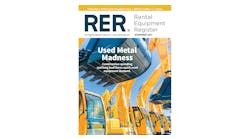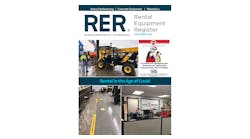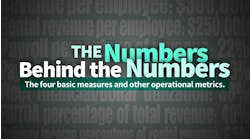In talking recently with independent rental store owners around the country, all seem to agree that the last 12 to 24 months have been the most challenging in their business careers. Some of the company owners we talk with feel that they are seeing the light at the end of the tunnel, while others worry about how much longer they can hold out financially if they do not see significant improvements soon.
In an interview published in the November 2009 issue of RER, JLG president Craig Paylor said his company is focusing on “What do we do so that we are better off when we come out of this thing?” I think this is the essence for all rental store owners no matter where they are at in this cycle.
One of the common issues my partner, Fred Hageman, and I are hearing from independent rental store owners is that they are experiencing increased competition from the national companies in their markets. Most, if not all, of the national companies are publicly traded in some form or have bonds and notes that are publicly traded; in either case, they are required to publicly discuss their financial results, including how they have managed their business during this downturn. Taking Paylor's comments to heart, I believe there are several lessons to be learned from how the nationals have coped with recent events as well as some lessons as to how independent rental store owners can differentiate themselves from national rental companies and create a competitive edge for their business.
Six ways to think (and manage) like a national
- Know, track and manage your metrics. One publicly traded company boasts that its managers have “access to real time metrics.”
Metrics are the key financial and operational measures that determine the strengths, weaknesses and trends in a rental company's performance. Much like driving a car and being able to glance at your dashboard to see key measurements, we recommend using your existing financial and rental software to create an “instrument cluster” to see the performance of your business at a glance. Often these reports can be generated directly from your software, other times you download data from your system into a program such as Excel to create a report. We recommend the following key metrics for your “instrument cluster:”
-
Revenues and revenue trends: Know your current revenues as of the close of the prior day's business. Be able to compare that data to previous comparable results including the most previous month and the same month last year. Also, be able to do similar comparisons against quarterly results and year-to-date results.
-
Payroll as percent of total revenue: You should track payroll expenses every pay period matching the expense with the revenue generated during the same period. Use fully burdened payroll including base pay, overtime, commissions, payroll taxes, contract labor, and employee health insurance and benefit expense. For general rental centers, your payroll should be no more than 30 percent of total revenues; for contractor-oriented rental centers your payroll expense should be no more than 25 percent of revenue. (Note: “General” rental denotes rental centers that rent smaller equipment to a mix of contractors and homeowners with a higher concentration of daily and weekly rentals as opposed to monthly rentals. These operations require more personnel and administrative expenses to handle the equipment and rental transaction since they generally have more daily and weekly rentals than a larger operation, hence the reason for the payroll differential. Contractor-oriented rental centers rent larger equipment primarily to contractors and have a high mix of monthly rentals that are mostly delivered.)
-
Rental fleet dollar utilization: Annual total rental revenue divided by your original cost of fleet. For general rental centers, we have recently relaxed our current standards to 80 percent with a long-term goal of 100 percent (i.e. $1 dollar of rental revenue for every dollar of original cost of fleet.) For contractor rental centers, our current target is 60 percent with a longer term goal of 70 percent or better.
-
Rental fleet repairs and maintenance expense: These expenses should range between 6-10 percent of rental revenue derived from your owned fleet. Track expenses by individual pieces of equipment. Identify and evaluate any individual pieces of equipment that are more than 10 percent. This metric is rising as companies age their fleets. Be careful to not exceed the top end of this measure!
-
EBITDA (cash flow) as a percent of total revenue: For contractor-oriented operations, our current target is a minimum of 30 percent with a longer term goal of 35 to 40 percent. For general rental centers, our current minimum target is 25 percent with a longer term goal of 30 percent or more. The difference in target EBITDA between general and contractor-oriented rental companies is a function of two primary reasons: 1) The reduced payroll filters straight to the bottom line and 2) Contractor-oriented operations tend to produce larger revenues, which tend to cover fixed operating expenses faster. Then, once fixed costs are covered, the incremental revenues tend to go in larger percentages to the bottom line.
Rest assured, there are many other metrics that can and should be measured (we recommend even more thorough tracking than the basics above). Each measure is important to your business and, believe me, all the national rental companies track these metrics and hold their managers accountable.
-
- Produce timely and accurate monthly financial statements
In order to properly track your metrics, you should have an income statement and balance sheet finalized by the 10th of every month for your previous month's results. These statements can be prepared internally by your staff or by your outside accountant, but the most important thing is that revenues and expenses should be consistently recorded from month-to-month. If your company does not already produce these statements, your CPA can assist you in setting up the process.
- Analyze all your expenditures and be prepared to negotiate
Look at every expense that comes through your business. Is this money you have to spend right now? Can it be deferred? Did you get the best price possible on your equipment and supplies? Shop everything, get prices from different vendors and be open to making changes. Whether it's insurance, uniforms, office supplies, rental equipment, resale merchandise or even your facility rent, better prices and/or terms can be negotiated in this economy.
- Work on your company's image
National rental companies have set the bar high with attractive facilities, interactive websites and well-maintained equipment. We often see the basic task of housekeeping as being one of the most overlooked components of a company's image. This also extends to employees, including personal appearance and phone etiquette. We have talked to many rental customers (contractors and homeowners alike) over the years that have expressed a preference to deal with locally owned companies given equal service and equipment.
Starting with your curbside appearance, make sure you are portraying the proper image to your customer. Make sure your website is informative, professional and up to date. Ensure that your equipment, including your delivery vehicles, look good even if your equipment has aged more than in the past. Don't discount the value of a new coat of paint and new decals. Make sure your counter people, mechanics and drivers are well groomed and have appropriate interactions with customers. As an owner or manager, frequently work the counter, ride with delivery drivers and sales people as a training and monitoring tool for customer interaction.
- Diversify your geography, leverage your investment and create synergies with shared overhead
This may be with an additional location or locations within your current market or with an expansion into an adjacent market. History tells us the most successful independent rental companies have expanded in recessions! The national company model works more efficiently and profitably than single-store independents as nationals with multiple locations can share equipment, thereby increasing time and dollar utilization, within reasonable driving distances. This also allows for shared overhead such as accounting, human resources and computer systems. Take a hard look at your market area within 25, 50, 75 or 100 miles of your current locations for possible expansion. We've seen situations where good, established rental operations are willing to sell at reasonable prices.
- Focus on rental
In a down economy with increased rate pressure, we see many companies tempted by alternative sources of revenue other than rental. The most common “diversification” we see is increased emphasis on sales of new equipment or resale merchandise. With a few exceptions, we almost always disagree with this strategy. We often see this diversification into sales cause decreased margins, decreased rental revenues and usually an investment in merchandise or equipment that proves to be slow moving and ultimately obsolete. Study the strategy of the national rental companies. You will hear of reports to investors that the company “is focused on higher margin equipment rentals.” Most every national company has phased out or pared down new equipment and resale sales merchandise. Why? Depending on the way you account for rental income, rentals routinely generate gross margins of 60 to 80 percent. New equipment sales typically generates margins of 10 to 15 percent and resale merchandise, even if managed properly, only generate overall margins of 30 to 35 percent. These sales also demand attention from ownership, management, sales and support personnel. Why devote time away from higher margin rental revenue for low margin, high risk revenue sources? Follow the lead of the national companies and focus on rental. The time invested in rental, your core business, will always pay the biggest dividends.
Four ways to differentiate yourself and compete as a local independent company
- Promote your local image. Make it well known that you are a locally owned, independent company
Boldly proclaim this fact in all your marketing and advertising materials including your website, your invoices, on your trucks and if possible, as a part of your logo. Get involved in local civic and contractor associations. Advertise and support local high school sports and other local sports teams. Encourage your employees to be involved as well. Continue customer appreciation activities such as open houses and barbeques that promote customer loyalty. Continue to reward and entertain key accounts with personal focused activities such as fishing, hunting, ball games or golf.
- Maximize your opportunities to realize higher rental rates
On larger jobs in particular, you may need to concede most of the monthly rentals on larger equipment to the national companies. Focus on shorter term daily and weekly rentals with sub-contractors that are less rate sensitive. Sell your company as a “back-up” or a “just-in-time” source on items the national companies can't provide in a timely manner. Have a firm policy in place as to who can discount and by how much. Set walk-away rates on selected rate-sensitive equipment. Make sure you consider all aspects of a customer such as payment history, how they treat machinery, job application, potential for future business, etc. before offering a large discount. Used equipment pricing is at or near an all-time low. Consider buying late-model used and refurbished equipment to remain price competitive on categories such as reach forklifts, aerial equipment and backhoes that tend to be the most rate sensitive. Current used equipment pricing on late-model units may be one-third to one-half that of a new unit.
- Look for opportunities to improve your staff; create an all-star team by retaining your best employees and recruiting the best employees from other companies
Often, we see employees of large national companies experience frustration and feel they do not have a voice due to corporate bureaucracy, arbitrary policy or compensation changes. Establish a reputation as a great place to work. Offer a full range of benefits that are competitive with the national companies. Make it known that your employees are an important part of your operation and that you value their input. Communicate to your employees your short- and long-term goals for the company and let them know they are key to achieving these goals.
- Create a “Never Say No” mentality
We have seen several very successful local companies who embrace this philosophy create customer loyalty and in turn build market share that outpace the local branches of national competitors. In order to successfully do this, you must develop relationships with vendors including other rental companies, equipment dealers, specialty rental houses and resale product vendors. Never saying no may take the form of taking an order for 10 more light towers than you have in inventory, a large boomlift not in your fleet or a specialty air tool not in your stock. Upper management and/or ownership needs to be involved in this process to make sure you can deliver on this philosophy and deliver it without losing money. Make sure the customers you do this for are the right ones; i.e., they have strong potential for current and future business that falls into your mainstream and that their payment history merits this “extra mile” treatment.
Regardless of whether your company is back on the upswing or still struggling, make these positive changes, or get help in doing so from knowledgeable industry sources in 2010 to ensure that you will come out of this downturn better than when you went in.
Gary Stansberry is a partner in the rental industry consulting firm of Hageman, Stansberry & Associates. HS&A specializes in mergers and acquisitions, business valuations and operational consulting strategies to increase the cash flow and value of rental businesses. Visit www.rentaladvisors.com.





